Road Tests in France.
Page 15
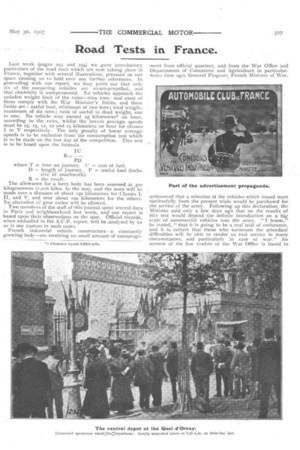
Page 16
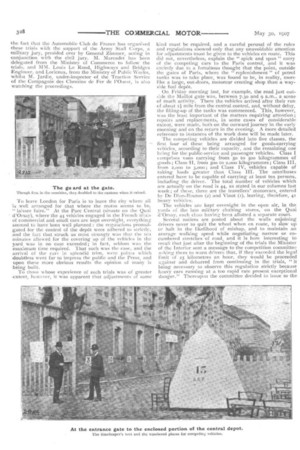
Page 17
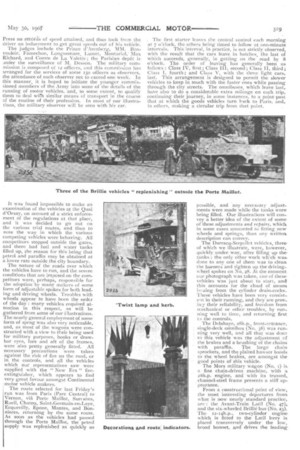
Page 18
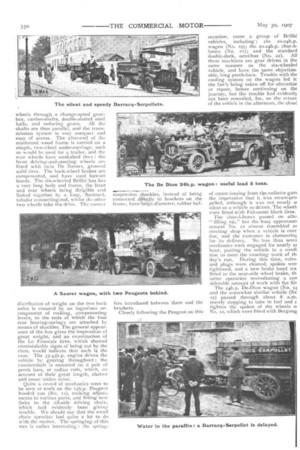
Page 19
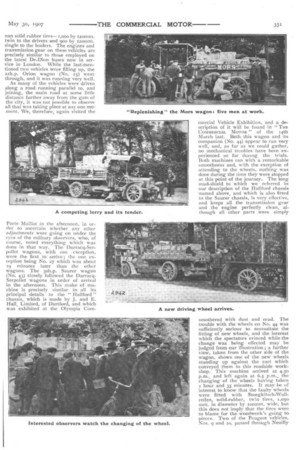
Page 20
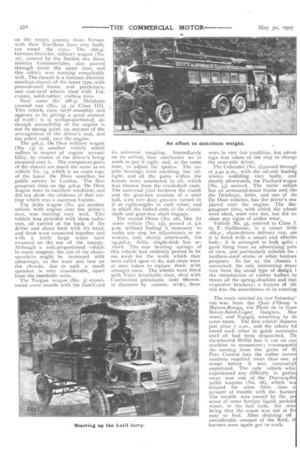
If you've noticed an error in this article please click here to report it so we can fix it.
Last week (pages 293 and 294.) we gave introductory particulars of the road tests which are now taking place in France, together with several illustrations, pressure on our space causing us to hold over any further references. In proceeding with our report, we may point out that only six of the competing vehicles are steam-propelled, and that electricity is unrepresented. No vehicles approach the unladen weight limit of the rules—nine tons—and most of them comply with the War Minister's limits, and these limits are : useful load, minimum of two tons; total weight, maximum of six tons; ratio of useful to dead weight, one to one. No vehicle may exceed 25 kilometres* an hour, according to the rules, whilst the lowest average speeds must be 15, /5, 12, ro and 15 kilometres an hour for classes I to V respectively. The only penalty of lower average speeds is to be exclusion from the consumption test which is to be made on the last day of the competition. This test is to be based upon the formula
TC 12=-- PD where T = time on journey. C = cost of fuel.
D = length of journey. P = useful load (inclusive of coachwork).
R = the result.
The allowance for a lorry body has been assessed at 300 kilogrammes (r,ot6 kilos. to the ton), and the tests will be made over a distance of about 150 kilometres for Classes I, II, and V, and over about too kilometres for the others. No alteration of gear ratios will be allowed.
Two members of the staff of this journal spent several days in Paris and neighbourhood last week, and our report is based upon their observations on the spot. Official records, when embodied in the A.C.F. report, will be analysed by us as is our custom in such cases.
French industrial vehicle constructors—a constantly growing body—are receiving no small amount of encourage ment from official quarters, and from the War Office and Departments of Commerce and Agriculture in particular. Some time ago, General Picquart, French Minister of War.
anliounced that a selection of the vehicles which issued most gu'c&ssfully from the present trials would be purchased for the. service of the army. Following up this declaration, the Minister said only a few days ago that on the results of this test would depend the definite introduction on -a big scale of commercial vehicles into the army. "I know," he stated, " that it is going to be a real trial of endurance, and it is certain that those who surmount the attendant difficulties will be able to render us real service in many circumstances, and particularly in case of war." An earnest of the boa vouloir of the War Office is found in the fact that the Automobile Club de France has organised these trials with the support of the Army Staff Corps, a military jury, presided over by General Zimmer, acting in conjunction with the civil jury. M. Marcadet has been delegated from the Ministry of Commerce to follow the trials, and MM. Louis be Rond, Highways and Bridges Engineer, and Loriceux, from the Ministry of Public Works, whilst M. Jardin, under-inspector of the Traction Service of the Compagnie des Chemins de For de l'Ouest, is also watching the proceedings.
To leave London for Paris is to leave the city where all is well arranged for that where the motto seems to be " laissez faire." At the Parc Central (situate on the Ouai d'Orsay), where the 44 vehicles engaged in the French trials of commercial and small cars are kept overnight, everything seemed to have been well planned : the regulations promulgated for the control of the depot were adhered to strictly, and the fact that struck us most strongly was that the ten minutes allowed for the covering up of the vehicles in the yard was in no case exceeded; in fact, seldom was the maximum time required. That such was the case, and the arrival of the cars in splendid trim, were points which doubtless went far to impress the public and the Press, and upon these more obvious results the opinion of many is being built.
To those whose experience of such trials was of greater ,extent, however, it was apparent that adjustments of some
kind must be required, and a careful perusal of the rules and regulations showed only that any unavoidable attention for adjustments must he given to the vehicles en route. This did not, nevertheless, explain the " spick and span " entry of the competing cars to the Paris control, and it was entirely due to a fortuitous thought that the point, outside the gates of Paris, where the " replenishment " of petrol tanks was to take place, was found to be, in reality, more. like a large, out-doors, motorcar erecting shop than a wayside fuel depot.
On Friday morning last, for example, the road just outside the Maillot gate was, between 7.30 and 9 a.m., a scene of much activity. There the vehicles arrived after their run of about ti mile from the central control, and, without delay, the filling-up of the tanks was commenced. This, however, was the least important of the matters requiring attention; repairs and replacements, in some cases of considerable extent, were made, both on the outward journey in the early morning and on the return in the evening. A more detailed reference to instances of the work done will be made later.
The competing vehicles are divided into five classes, the first four of these being arranged for goods-carrying vehicles, according to their_ capacity, and the remaining one
being for the public-service and passenger vehicles. Class I comprises vans carrying from so to soo kilogrammes of goods ; CiassiI, from 500 to-2,000 kilogrammes ; Class III, from 2,000 LO 33000 and Class IV, vehicles capable of taking loads greater than Class III. The omnibuses
entered have to be capable of carrying at least ten persons, including the driver. The total number of vehicles which are actually on the road is 44, as stated in our columns last
week ; of these, three are the travellers' motorcars, entered by De Dion-Houton (2) and Viriot (r), leaving, therefore, 41 heavy vehicles..
The vehicles are kept overnight in the open air, in the yards of the late military clothing stores, on the Quai d'Ors;av, each class having been allotted a separate court.
Several notices are posted about the walls enjoining drivers never to quit the wheel when en route, to slow up or halt in the likelihood of mishap, and to maintain an average walking speed while negotiating narrow Or encumbered stretches of road, and it is here interesting to recall that just after the beginning of the trials the Minister of the Interior sent a message to the competition committee asking them to warn drivers that, if they exceeded the legal limit of 25 kilometres an hour, they would be proceeded
against and debarred fromcontinuing in the trials, " it being necessary to observe this regulation strictly because heavy cars running at a too rapid rate present exceptional danger." Thereupon the committee decided to issue to the
Press no rttilfc.IS of speed attained, and thus took from the driver an inducement to get great speeds out of his vehicle.
The judges include the Prince &Arenberg, MM. Bonvouloir, Famechon, Longuemare, Lumet, Montariol, Max Richard, and Comte de La Valette ; the Parisian depot is Inder the surveillance of M. Desson. The military commission is composed of 12 officers, and this commission has arranged for the services of some 150 officers as observers, the attendance of each observer not to exceed one week. In this manner, it is hoped to initiate the younger commissioned members of the Army into some of the details of the running of motor vehicles, and, to some extent, to qualify them to deal with similar means of transport in the course of the routine of their profession. In most of our illustrations, the military observer will be seen with his car.
It was found impossible to make an examination of the vehicles at the Quai d'Orsay, on account of a strict enforcement of the regulations at that place, and it was decided to go out on the various trial routes, and thus to note the way in which the various competing vehicles were behaving. All competitors stopped outside the gates, and there had fuel and water tanks filled up, the reason for this being that petrol and paraffin may be obtained at a lower rate outside the city boundary. The nature of the roads over which the vehicles have to run, and the severe conditions that are imposed on the competitors were, perhaps, responsible for the adoption by many makers of some form of adjustable spokes for both leading and driving wheels. Troubles with wheels appear to have been the order of the day : many vehicles required attention in this respect, as will be gathered from some of our illustrations. The nearly general employment of some form of sprag was also very noticeable, and, as most of the wagons were constructed with a view to their being used for military purposes, hooks or draw bar eyes, fore and aft of the frames, were also pretty generally fitted. All necessary precautions were taken against the risk of fire on the road, or in the controls, and all the vehicles which our representatives saw were supplied with the " New Era " fireextinguisher, which appears to find very great favour amongst Continental motor vehicle makers.
The route selected for last Friday's run was from Paris (Parc Central) to Vernon, via Porte Maillot, Suresnes,
Rueil, Chatou, Saint-Germain-en-Laye, Ecquevilly, Epone, Mantes, and Bon
nieres, returning by the same route. As soon as the vehicles had passed through the Porte Maillot, the petrol supply was replenished as quickly as
. The first starter leaves the central control each morning at 7 &clock, the others being timed to follow at one-minute intervals. This interval, in practice, is not strictly observed, with the result that the cars leave in batches, the last of which succeeds, generally, in getting on the road by 8 o'clock. The order of leaving has generally been as follows : Class IV, first ; Class III, second ; Class II, third ; Class I, fourth ; and Class V, with the three light cars, last. This arrangement is designed to permit the slower vehicles to keep in touch with the faster ones while passing through the city streets. The omnibuses, which leave last, have also to do a considerable extra mileage on each trip, continuing their journey, in some instances, to a point•past that at which the goods vehicles turn hack to Paris, and, in others, making a circular trip from that point.
possible, and any necessary adjust meats were made while the tanks were
filled. Our illustrations will convey a better idea of the extent of someof these adjustments and repairs, which, in some cases amounted to fitting new wheels and springs, than any written description can convey. The Darracq-Serpollet vehicles, threeof which we illustrate, were, however,. quickly ..under. way, after filling up thetanks : the only other work whTch was. done to any one of. them was to clean
the burner S and tighten up the driving-. wheel spokes on No, 2:8. At the moment.
our photograph was taken, one of these.
vehicles was just about to start, an this accounts for the cloud of steam is,.uing from the eylinder drain-cocks..
These vehicles have been very consist ent in their running, and they are proving their reliability, and freedom from mechanical or other-troubles, by running well to time,, and returning first to the controls, The Delahaye, 28h.p., front-entrance, single-deck omnibus. (No,. 38) was run ning very well, and all that was done to this vehicle was the adjustment of the brakes and a brushing of the chains with paraffin. The large chain sprockets, and the plaited hawser bands to the wheel brakes, are amongst the gobd points of this vehicle. The Mors military wagon (No. 1) is. a fine chain-driven machine, with a 28h.p. engine, and with its trussed, channel-steel frame presents a stiff aps pearance.. From a constructional point of view, the most interesting; departures from what is now nearly standard practice,
are.: the Avant-Train Lad) (No. 47), and the six-wheeled Brillie bus (No. 23).
The ;2-1411,p.. two-cylinder engineWhich is fitted' to the Lath lorry is. placed transversely under the low, broad bonnet, and drives the leading wheels through a change-speed gearbox, cardanshafts, double-slotted steel
balls, and reducing gears. All the shafts are thus parallel, and the transmission system is very compact and easy of access. The after-end of the reinforced wood frame is carried on a simple, two-wheel under-carriage, such as would be used for a trailer, and the rear wheels have steel-shod tires : the front driving-and-steering wheels are fitted with twin De Nevers, grooved solid tires. The back-wheel brakes are compensated, and have steel hawser bands. The six-wheeled Brillie bus has a very long body and frame, the front and rear wheels being dirigible and linked together by a long, flattened, tubular connecting-rod, whilst the other two wheels take the drive. The correct distribution of weight on the two back axles is ensured by an ingenious arrangement of rocking, compensating levers, to the ends of which the four rear hearing-springs are attached by means of shackles. The general appearance of the bus gives the impression of great weight, and an examination of the Le Francais tires, which showed unmistakable signs of being cut by the rims, would indicate that such is the case. The 35-45h.p. engine drives the vehicle by gearing throughout : the countershaft is mounted on a pair of perch bars, or radius rods, which, on account of their great length, chatter and cause undue noise.
Quite a crowd of mechanics were to be seen at work on the ish.p. Peugeot hooded van (No. II), making adjustments to various parts, and fitting new links to the off-side driving chain, Which had evidently been giving trouble. We should say that the small chain sprocket had quite a lot to do with the matter. The springing of this Van is rather interesting : the spring suspension shackles, instead of being connected dkeetiv to brackets on the frame, have-large-diameter, rubber buf
fers introduced between them and the brackets.
Closely following the Peugeot on this
occasion, came a group of BrillM vehicles, including : the 2o-24h.p. wagon (No. 19); the 2o-2411.p. char-abanes (No. 21); and the standard double-deck, omnibus (No. 22). All these machines are gear driven in the same manner as the six-wheeled vehicle, and have the same objection. able, long perch-bars. Trouble with the cooling system on the wagon led tc the fan's being taken off for alteration or repair, before continuing on the journey, but the trouble had evidently not been remedied, for, on the return of the vehicle in the afternoon, the cloud
of steam issuing from th.e.-radiator gavt the impression that it was steam-pro pelled, although it was not nearly s< silent as a vehicle so driven. The wheel: were fitted with Falconnet block tires.
The char-a-bancs passed on aftel " filling up," but the busy appearano around No. 22 almost resembled at erecting shop when a vehicle is over due, and the customer is clamourinE for its delivery. No less than sever mechanics were engaged for nearly at hour, putting the vehicle in a condi tion to meet the exacting work of th. day's run. During this time, valve and plugs were cleaned, spokes wen tightened, and a new brake band wa fitted to the near-side wheel brake, tb. latter operation necessitating a con siderable amount of work with the file The 2411.p. De-Dion wagon (No. 14 and the somewhat similar vehicle (Nc 12) passed through about 8 a.m. merely stopping to take in fuel and t tighten the spokes of the wheels oi No. 12, which were fitted with Bergoug
nan solid rubber tires-1,00o by 12omm. twin to the drivers and goo by I20nit11. single to the leaders. The engines and transmission gear on these vehicles are precisely similar to those employed on the latest De-Dion buses now in service in London. While the last:mentioned two vehicles were filling up, the 22h.p. Orion wagon (No. 25) went through, and it was running very well. As many of the vehicles were driven along a road running parallel to, and joining, the main road at some little distance further away from the gate of the city, it was not possible to observe all that was taking place at any one moment. We, therefore, again visited the
Porte Maillot in the afternoon, in order to ascertain whether any other adjustments were going on under the eyes of the military observers, who, of course, noted everything which was done in that way. The Darracq-Serpollet wagons, with one exception, were the first to arrive ; the one exception being No. 27 which was about Ig minutes later than the other wagons. The 30h.p. Saurer wagon (No. 43) closely followed the DarracqSerpollet wagons in order of arrival in the afternoon. This make of machine is precisely similar in all its principal details to the " Hallford " chassis, which is made by J. and E. Hall, Limited, of Dartford, and Which was exhibited at the Olympia Corn mercial Vehicle Exhibition, and a description of it will be found in " THE COMMERCIAL MOTOR " of the t4th March last. Both this wagon and its companion (No. 44) appear to run very well, and, as far as we could gather, no mechanical troubles have been experienced so far during the trials. Both machines ran with a remarkable smoothness and, with the exception of attending to the wheels, nothing was done during the time they were stopped at this point of the journey. The long mud-shield to which we referred in our description of the Hallford chassis named above, and which is also fitted to the Saurer chassis, is very effective, and keeps all the transmission gear and the engine perfectly clean, although all other parts were simply
smothered with dust and mud. The trouble with the wheels on No. 44 was sufficiently serious to necessitate the fitting of new wheels, and the interest which the spectators evinced while the change was being effected may be judged from our illustration ; a further view, taken from the other side of the wagon, shows one of the new wheels standing up against the cart which conveyed them to this roadside workshop. This machine arrived at 4.30 p.m., and left again at 6.5 p.m., the changing of the wheels having taken hour and 35 minutes. It may he of interest to know that the faulty wheels were fitted with Stoegkitsch-Wollreifen, solid-rubber, twin tires, 1,o5o mm. in diameter by toomm. wide, but this does not imply that the tires were to blame for the woodwork's going to. pieces. Two of the Peugeot vehicles, Nos, g and to, passed through Neuilly on the return journey from Vernon with their Tonilhon tires very badly cut round the rims. The 28h.p. German-Daimler, military wagon (No. 16), entered by the Societe des Automobiles Cornmerciales, also passed through about the same time, and this vehich. was running remarkably well. The chassis is a German-Daimler omnibus chassis of the latest type, with pressed-steel frame and perch-bars, and cast-steel wheels shod with Falconnet, solid-rubber, endless tires.
Next came the 28h.p. Delahaye covered van 37.._in Class Ill). This vehicle runs very, smoothly and appears to be giving a good account of itself : it is well-proportioned, although accessibility of the engine is not its strong point, on account of the arrangement of the driver's seat, and the petrol tank, over the engine.
The 3oh.p. De Dion military wagon (No. 13) is another vehicle which suffers in respect of engine accessibility, by reason of the driver's being mounted over it. The component parts of the chassis are much the same as on vehicle No. 14, which is an exact copy of the latest De Dion omnibus for public service in London. The Bergougnan tires on the rh.p. De Dion wagon were in excellent condition, and did not show the evidence of that cutting which was a common feature.
The Aries wagon (No. 40) another vehicle with engine over the driver's seat, was running very well. This vehicle was provided with three radiators, all carried at the .back of the driver and about level with his head, and these were connected together and with a fairly large water tank mounted on the top of the canopy. Although a well-proportioned vehicle in many respects, the sizeof the chainsprockets might be increased with advantage, as the wear and tear on the chassis, due to such a small sprocket, is very considerable, apart from the inevitable noise.
The Turg-an wagon (No. 3) experienced some trouble with the clutch and
its universal coupling. Immediately on its arrival, four mechanics set to work to put it right, and, at the same time, to adjust the spokes. The engine bearings were anything but oiltight, and all the parts within the bonnet were smothered in oil, which was thrown from the crankshaft ends. The universal joint between the clutch and the gear-box consists of a steel ball, with twO• deep grooves turned in it at right-angles to each other, and in which the forked ends of the clutchshaft and gear-box shaft engage.
The second Orion (No. 26), like its sister vehicle (No. 25), passed at 5.6 p.m. without finding it necessary to make any stop for adjustments or renewals, and, shortly afterwards, the 24-30h.p. Aries, •single-deck bus arrived. The rear bearing springs of this vehicle had evidently proved to be too weak for the work which they were called upon to do, and steps were at once taken to replace them with stronger ones. The wheels were fitted with Vinet detachable rims, shod with Continental pneumatic tires 88omm.. in diameter by 120mm. wide; these
were in very fair condition,. but advan tage was takenof the stop to chang( the near-side driver.
The Cohendet (No. 2) passed througl at 540 p.m., with the off-side leading wheels wobbling .very badly, and shortly afterwards, the Pan hard wagor (No. 33) arrived. The latter vehich has an armoured-wood frame and, ilk( the Delahaye, Aries, and one of tht De Dion vehicles, has the driver's sea placed over the engine. The Bee gougnan tires, with which the wheel: were shod, were very hot, but did no show any signs of undue wear.
Vehicle No. 35, entered in Class F by F. .Guilherme, is a smart little 16h.p., chain-driven delivery van, aru it is fitted with a smart and effectivl body : it is arranged to look quite good thing from an advertising poin of view, and particularly suitable for medium-sized stores or other busines purposes. As far as the chassis i concerned, the only interesting depar
• ture• from the usual type of design i the introduction of rubber buffers be tween all the spring-shackles and thei respective brackets.; a feature of thi van was the smoothness of its running The route selected for last Saturday' run was from the Qual d'Orsay ti Maison-Rouge„ via Porte de la Care Boissy-Saint-Leger, Guignes, Mom' mant, and Naugis, returning by fir same route. The first vehicle departel just after 7 a.m., and the others fol lowed each other in quick successiot until all had been despatched. Th six-wheeled Brillie bus is not an eas machine to manceuvre; consequentl the turning from the gates of th Parc Central into the rather narro roadway required more than one a tempt before it was successful] negotiated. The only vehicle whic experienced any difficulty in gettin away was one of the Darracq-Se pullet wagons (No. 28), which w delayed for some little time o account of trouble with the burner The trouble was caused by the pr sence of some foreign liquid, probabl water, in the fuel tank, the resu being that the cause was not at fir easy to find. After draining off considerable amount of the fluid, t burners were again got to work.


























